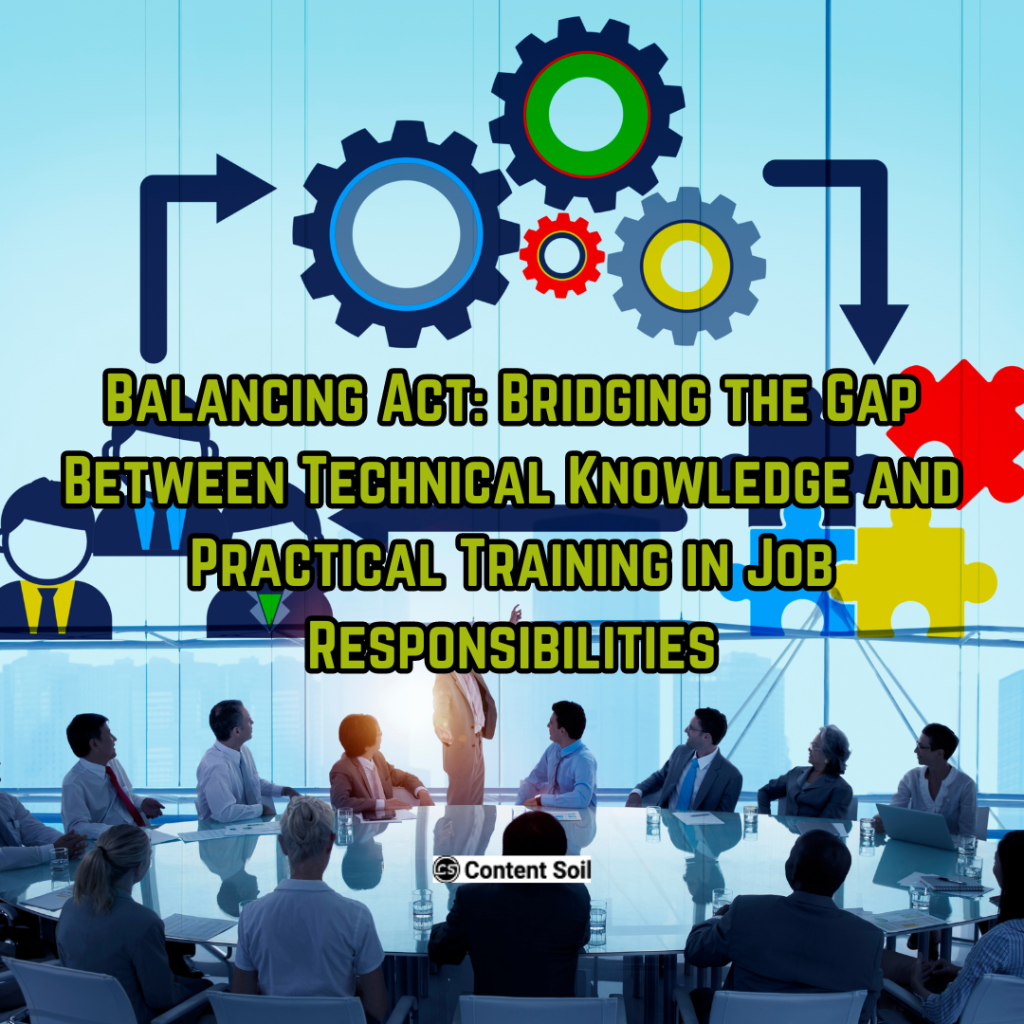Introduction:
In today’s dynamic and competitive professional landscape, possessing both technical knowledge and practical training is essential for success in virtually every industry. However, there exists a significant distinction between the two concepts that often gets overlooked or misunderstood.
While technical knowledge equips individuals with a theoretical understanding of concepts, principles, and procedures relevant to their field, practical training involves hands-on experience, skill development, and the application of knowledge in real-world scenarios. Understanding the difference between these two aspects is crucial for individuals, employers, and educators alike, as it impacts the effectiveness of workforce development, job performance, and overall career progression.
In this exploration, we delve into the disparities between technical knowledge and practical training of job responsibilities. We will examine the unique characteristics, benefits, and challenges associated with each aspect, as well as the synergies that arise when they are integrated effectively. Through this analysis, we aim to provide insights into how individuals can optimize their learning and development strategies, how organizations can enhance their training programs, and how educators can tailor their instructional approaches to better prepare learners for the demands of the modern workplace.
Join us as we navigate the intricacies of technical knowledge and practical training, uncovering their respective roles in shaping the capabilities and competencies of professionals across various domains.
Nature of Learning:
Technical knowledge typically involves the acquisition of theoretical concepts, principles, and frameworks relevant to a specific field or job role. This learning is often obtained through formal education, self-study, or specialized training programs. On the other hand, practical training focuses on hands-on experience, allowing individuals to apply theoretical knowledge in real-world settings, develop skills, and gain proficiency through practice and feedback.
Focus on Theory vs. Application:
Technical knowledge emphasizes understanding the underlying theories and concepts behind processes, methodologies, and tools used in a particular field. It provides a foundation upon which practical skills can be built. In contrast, practical training centers on the application of knowledge in practical scenarios, enabling individuals to develop the skills required to execute tasks, solve problems, and achieve specific objectives in a work environment.
Learning Environment:
Technical knowledge is often acquired in formal educational settings such as schools, colleges, or online courses, where the focus is on delivering information through lectures, readings, and assignments. Practical training, however, takes place in real or simulated work environments where individuals engage in hands-on activities, simulations, role-playing exercises, and on-the-job experiences under the guidance of experienced professionals.
Duration and Intensity:
Technical knowledge acquisition can vary in duration and intensity, ranging from short-term courses to multi-year degree programs, depending on the complexity and depth of the subject matter. Practical training, on the other hand, is typically more intensive and immersive, requiring individuals to actively engage in tasks and projects over a concentrated period to develop proficiency and competency.
Skill Development:
While technical knowledge provides the theoretical framework necessary for understanding concepts, practical training focuses on skill development and competency enhancement. Through practical training, individuals not only learn how to perform specific tasks but also develop problem-solving abilities, decision-making skills, and adaptability required to navigate real-world challenges effectively.
Feedback and Evaluation:
In technical knowledge acquisition, assessment often revolves around exams, quizzes, and assignments designed to evaluate understanding and retention of theoretical concepts. In practical training, feedback is integral, with individuals receiving guidance, coaching, and constructive criticism from mentors, supervisors, or peers as they apply their skills in real or simulated work environments. This feedback loop is essential for identifying areas of improvement and refining performance.
Transferability of Skills:
Technical knowledge, once acquired, can be applied across different contexts and scenarios within a particular field, providing individuals with a broad understanding of fundamental principles. Practical training, however, is often more context-specific, focusing on the development of skills tailored to a specific job role, industry, or organizational environment. While the skills gained through practical training are highly applicable to the target context, they may require adaptation when applied in different settings.
Risk and Consequence Management:
Practical training offers the opportunity for individuals to experience and learn from real-world challenges, mistakes, and successes in a controlled environment. This exposure allows them to develop risk management skills, learn from failures, and understand the consequences of their actions within a safe setting. In contrast, the consequences of errors in technical knowledge application are typically less immediate and tangible, as they are often theoretical in nature.
Integration of Theory and Practice:
The integration of technical knowledge and practical training is essential for holistic learning and skill development. While technical knowledge provides the theoretical foundation, practical training enables individuals to contextualize and apply that knowledge, reinforcing understanding and enhancing retention. Effective integration ensures that individuals not only grasp concepts but also develop the ability to translate them into actionable strategies and solutions.
Continuous Learning and Development:
Both technical knowledge and practical training are ongoing processes that require continuous learning and development to keep pace with evolving technologies, methodologies, and industry trends. Individuals must balance the acquisition of new theoretical knowledge with opportunities for practical application and skill refinement throughout their careers to remain competitive and adaptable in the rapidly changing job market.
Conclusion:
Effectively bridging the gap between technical knowledge and practical training is essential for navigating the complexities of job responsibilities in today’s professional landscape. This balancing act requires individuals to seamlessly integrate theoretical understanding with hands-on experience, fostering a culture of continuous learning and adaptability. Employers must provide opportunities for practical training and mentorship, while educators should design a curriculum that emphasizes real-world application. By embracing this holistic approach, individuals can develop the versatile skill set needed to excel in their roles, driving innovation and organizational success in an ever-evolving work environment.


